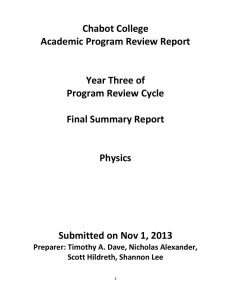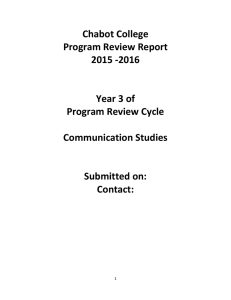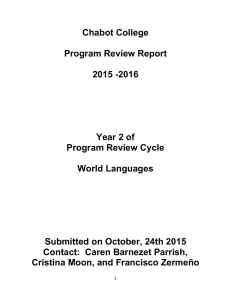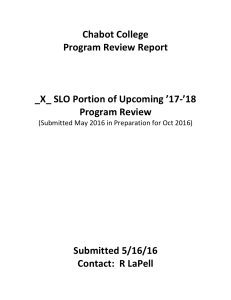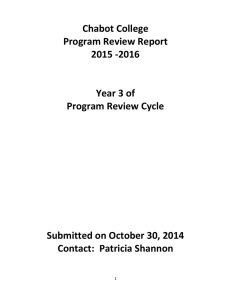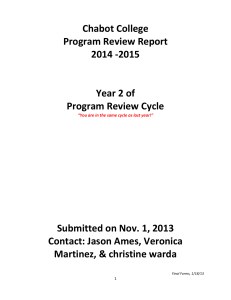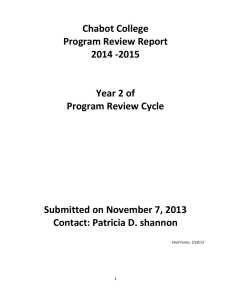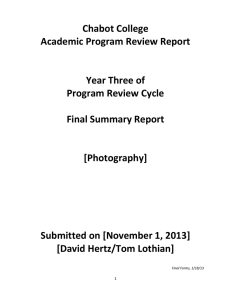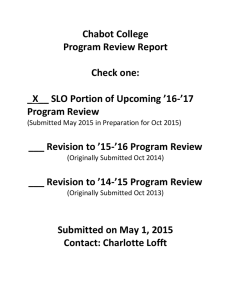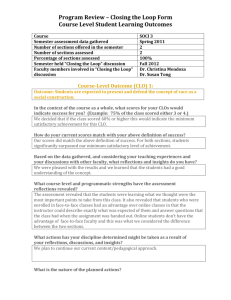Chabot College Program Review Report 2015 ‐2016
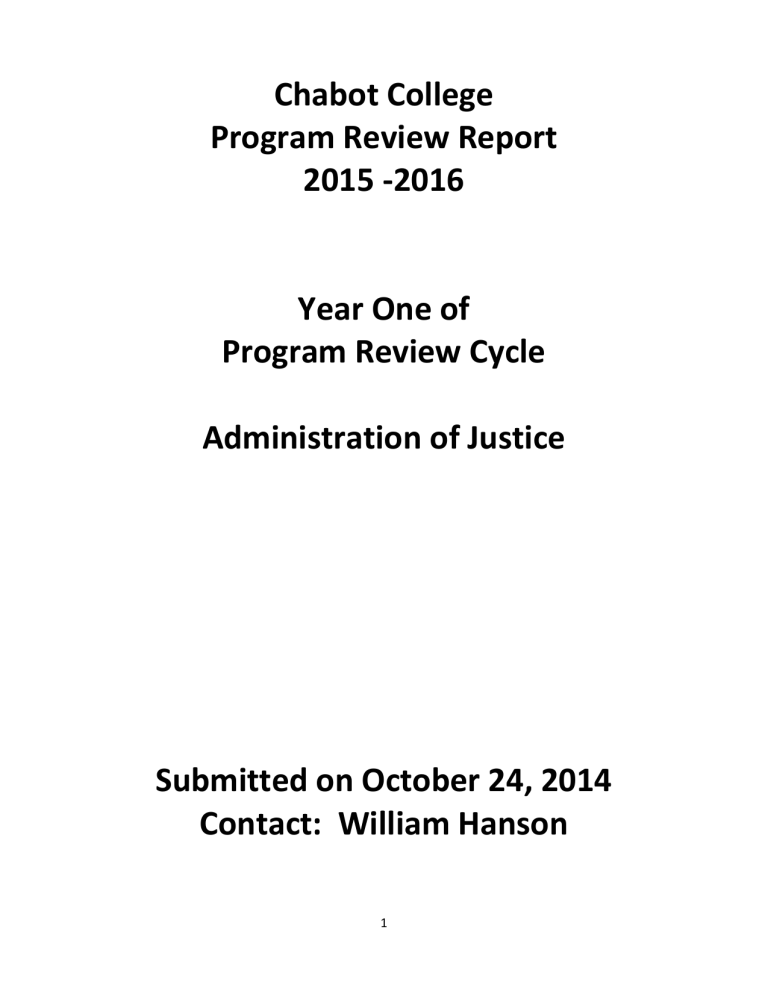
Chabot
College
Program
Review
Report
2015
‐
2016
Year
One
of
Program
Review
Cycle
Administration
of
Justice
Submitted
on
October
24,
2014
Contact:
William
Hanson
1
Appendix
B2:
“Closing
the
Loop”
Course
‐
Level
Assessment
Reflections.
Course
Semester assessment data gathered
Number of
Number of sections assessed
Percentage
sections of
offered sections
in the assessed
semester
Semester held “Closing the Loop” discussion
ADMJ/POSC 45 – Law & Democracy
Fall
1
1
Fall
2013
100%
2014
Faculty members involved in “Closing the Loop” discussion William Hanson/Sara Parker
Form Instructions:
Complete a separate Appendix B2 form for each Course ‐ Level assessment reported in this
Program Review.
These courses should be listed in Appendix B1: Student Learning Outcomes
Assessment Reporting Schedule.
Part I: CLO Data Reporting .
For each CLO, obtain Class Achievement data in aggregate for all sections assessed in eLumen.
Part II: CLO Reflections .
Based on student success reported in Part I, reflect on the individual
CLO.
Part III: Course Reflection.
In reviewing all the CLOs and your findings, reflect on the course as a whole.
P
ART
I: C
OURSE
‐ L
EVEL
O
UTCOMES
– D
ATA
R
ESULTS
C ONSIDER T HE C OURSE ‐ L EVEL O UTCOMES I NDIVIDUALLY ( THE
N UMBER OF CLO S WILL DIFFER BY COURSE
(CLO) 1: Analyze the cultural,
) economic, environment of civil rights movements.
and political
(CLO) 2: Apply legal concepts to contemporary political debates.
Defined Target
Scores*
(CLO Goal)
At least 65% of the class scoring a 3 or 4.
At least 65% of the class scoring a 3 or 4.
Actual Scores**
(eLumen data)
Approximately
65% of the class scoring a 3 or 4.
Approximately
80% of the class scoring a 3 or 4.
(CLO) 3: Define and evaluate three basic features of At least 65% of
American democratic government: representation, citizenship, participation.
the class scoring a 3 or 4.
If more CLOs are listed for the course, add another row to the table.
Approximately
75% of the class scoring a 3 or 4.
* Defined Target Scores :What scores in eLumen from your students would indicate success for this CLO?
(Example: 75% of the class scored either 3 or 4)
**Actual scores: What is the actual percent of students that meet defined target based on the eLumen data collected in this assessment cycle?
2
P
ART
II: C
OURSE
‐
LEVEL
O
UTCOME
R
EFLECTIONS
A.
C
OURSE
‐ L
EVEL
O
UTCOME
(CLO)
1:
1.
How do your current scores match with your above target for student success in this course level outcome?
The students met the target on this CLO but will continue to work on ways to help students think about topics from multiple angles.
2.
Reflection: Based on the data gathered, and considering your teaching experiences and your discussions with other faculty, what reflections and insights do you have?
This class is informally known as a “capstone” course, meaning that we set high expectations for students.
It is important that students are able to do more than merely define civil rights movements but also to put it in a context.
We have continuously improved the set of readings we provide the students and incorporated additional structure, reading, writing, and annotation support into the course.
B.
C OURSE ‐ L EVEL O UTCOME (CLO) 2:
1.
How do your current scores match with your above target for student success in this course level outcome?
The class exceeded this target.
2.
Reflection: Based on the data gathered, and considering your teaching experiences and your discussions with other faculty, what reflections and insights do you have?
We have been very successful at developing a model whereby students are taught how to, and then given the opportunity to practice regularly, applying a political and a legal lens to contemporary issues.
This is one of the first topics we cover in class.
We then demonstrate how to use the IRAC technique (Issue, Rule, Application, Conclusion) to evaluate and assess issue.
3
C.
C OURSE ‐ L EVEL O UTCOME (CLO) 3:
1.
How do your current scores match with your above target for student success in this course level outcome?
Students also exceeded the target on this CLO.
Students are able to go beyond the definitions and to really demonstrate their familiarity with the complexity of these topics.
For example, students are able to speak to both sides of issues; are able to demonstrate how the way we think about these concepts have changed over time; and how seemingly straightforward concepts (such as “representation”) are often far more complicated in practice.
2.
Reflection: Based on the data gathered, and considering your teaching experiences and your discussions with other faculty, what reflections and insights do you have?
This course ‐ learning outcome is very relevant to students.
We continue to try to find ways to tap into that natural connection in class and through extra ‐ curricular opportunities.
This year we were able to do this very successfully with the Vote60by50 campaign that strives to bring attention to and raise our campus ‐ voting rate to 60% by the 50 th Anniversary of the Voting Rights Act.
4
P
ART
III: C
OURSE
R
EFLECTIONS
AND
F
UTURE
P
LANS
1.
What changes were made to your course based on the previous assessment cycle, the prior
Closing the Loop reflections and other faculty discussions?
Based on the data we have gathered and analyzed, we made changes in the assignment structure to the course.
We ask students to write regularly – both in “think pieces” and during in ‐ class essays.
These opportunities give students the chance to practice what is described above in Part II, get frequent feedback, and improve the next time.
It also challenges students to be able to articulate their ideas under different circumstances (such
as brief written work, longer substantive writing, and under time constraints).
We have updated our reading every semester since initially offering the course.
The updates have allowed us to: a) ensure that the curriculum is contemporary and the topics are current; b) make improvements based on our assessment of what articles, chapters, etc.
worked well and which ones did not.
2.
Based on the current assessment and reflections, what course ‐ level and programmatic strengths have the assessment reflections revealed?
What actions has your discipline determined might be taken as a result of your reflections, discussions, and insights?
The assessment reveals strength in critical thinking training.
Students are being taught how to think and express their ideas based on close analysis of text and through regular class
activities and discussions.
We find that incorporating an opportunity for smaller group work as part of an activity or guided discussion questions every class allows students to practice this analysis.
Therefore, we have modified our teaching practice to incorporate this kind of work into almost every
lecture.
We have also found that it is more effective to cover few topics more deeply, so we have eliminated two broad topics from our syllabus, but incorporated more scholarship and perspectives into the other topics.
This has also improved students’ ability to make connections between topics, which is extremely beneficial in helping them achieve the college wide goals of critical thinking and communication.
In this team ‐ taught course, students benefit from the unique attributes and styles of both instructors.
Therefore we have increased the degree to which students are mixed up in their discussion sections.
This also gives the instructors the opportunity to work with all of the
students on a regular basis, not just those who are in their assigned section.
Lastly, we updated the CLOs and rubric for Law and Democracy in Fall 2014.
3.
What is the nature of the planned actions (please check all that apply)?
Curricular
Pedagogical
Resource based
Change to CLO or rubric
Change to assessment methods
Other: Instructor ‐ Student engagement
5
Appendix
C:
Program
Learning
Outcomes
Considering your feedback, findings, and/or information that has arisen from the course level discussions, please reflect on each of your Program Level Outcomes.
Program: Administration of Justice [Courses were assessed in the last program cycle]
PLO #1: Evaluate and analyze criminal justice issues and topics using knowledge of criminal justice institutions, terminology, theory and ethical issues in crime and justice.
PLO #2: Understand the interdisciplinary nature of criminal justice and the varying perspectives of the liberal arts and sciences as related to law enforcement, courts, and corrections.
What questions or investigations arose as a result of these reflections or discussions?
Explain: Administration of Justice is an interdisciplinary program in that it draws on various disciplines in the social sciences for its concepts, theories, and practices.
This is particularly true for the introductory course in the program, ADMJ 50.
The success rate for ADMJ 50 is approximately 55% indicating that some students are having difficulty.
Our theory is that some students come to the course lacking basic skills, background knowledge of the criminal justice system, and knowledge of other disciplines (e.g., sociology, psychology, etc.) that inform the administration of justice.
Also, we draw students with a variety of career goals (e.g., law enforcement, pre ‐ law, corrections, probation & parole, and juvenile justice).
We need to develop clear career and educational pathways for all students in the discipline.
What program ‐ level strengths have the assessment reflections revealed?
Strengths revealed: Administration of Justice is the fourth largest major at Chabot (560 –
2014).
We draw students with a variety of career goals (e.g., law enforcement, pre ‐ law, corrections, probation & parole, and juvenile justice).
All of our courses are transferable to CSU and four of our courses satisfy the UC ‐ IGETC requirements.
Consequently, we attract both students seeking careers in the administration of justice as well as those who have an intellectual interest in the field and choose our courses to satisfy graduation and/or transfer
requirements.
Having diverse students in our courses enhances the learning for all students.
What actions has your discipline determined might be taken to enhance the learning of students completing your program?
Actions planned:Our new Associate in Science for Transfer degree (TMC) for Administration of
Justice was approved and became available in Fall 2013.
The degree requirements are aligned with requirements for the CSUs and provide guidance to students regarding the courses required for transfer in addition to assuring them of their preparation for transfer and upper ‐ division work.
Most importantly, the completion of the AS ‐ T degree gives students priority admission into an Administration of Justice/Criminal Justice program in the CSU system.
The new AS ‐ T degree is an excellent example of a clear pathway for our students seeking to
6
transfer and a career in law enforcement or corrections.
However, we have a significant number of students who have an interest in practicing public law (e.g., District Attorney, Public
Defender, etc.) but there is no clearly identified pathway beginning in community college.
Upon approval of our AS ‐ T degree, I will be submitting a proposal to modify our existing AA degree to focus on a pre ‐ law curriculum.
We are also submitting an application to be part of a
State Bar Initiative: Community College Pathway to Law School.
I will discuss the proposal in
greater detail under “New Initiatives”.
7
